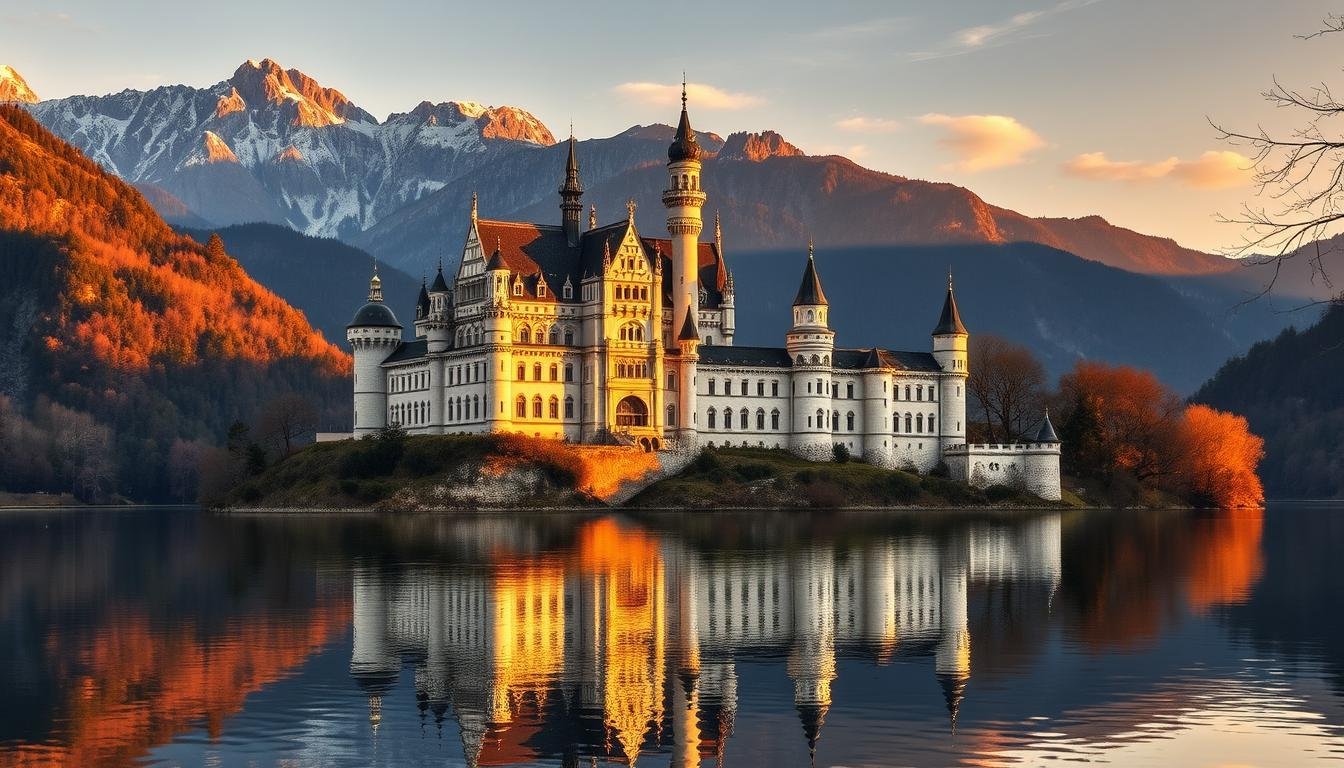Welcome to the enchanting world of Bavarian palaces, where fairy tales come to life. The region is home to some of Europe’s most breathtaking castles, steeped in history and romance.
Le Regge della Baviera, or the Bavarian palaces, have captivated the hearts of many. Their majestic architecture and cultural significance are unmatched. From the iconic Neuschwanstein Castle to lesser-known gems, these structures transport visitors to a world of wonder.
Key Takeaways
- Discover the enchanting world of Bavarian palaces.
- Explore the historical and cultural significance of these fairy tale castles.
- Visit iconic castles like Neuschwanstein and other hidden gems.
- Experience the romance and wonder of Bavaria’s castles.
- Learn about the architectural styles and influences.
The Enchanting World of Ludwig II’s Castles
King Ludwig II’s dream turned Bavaria into a land of fairy tale castles. These castles still amaze people from all over the world. Ludwig’s love for building and his wish to create something special drove this dream.
Introduction to Ludwig II
King Ludwig II was born in 1845 and became king at 18. He loved the arts and architecture, which shaped his legacy. His passion for romanticism and Richard Wagner’s work influenced his buildings.
Ludwig II spent most of his time building, away from royal duties. This made people wonder about his life and why he built such grand places.
The Legacy of a Romantic Visionary
The castles built under Ludwig II show his romantic dream. Neuschwanstein Castle is a highlight, blending fantasy with reality in 19th-century architecture.
| Castle | Location | Year Built |
|---|---|---|
| Neuschwanstein Castle | Bavaria, Germany | 1869-1886 |
| Hohenschwangau Castle | Bavaria, Germany | 1832-1836 (Renovated by Ludwig II) |
Ludwig’s work goes beyond his buildings. His dream of a romantic Bavaria has inspired many. Today, Ludwig II’s castles are a place of wonder, inviting visitors into a world of fairy tales and romance.
Neuschwanstein Castle: A Dream in Stone
The fairytale-like Neuschwanstein Castle sits in the Bavarian Alps. It was Ludwig II’s dream. This castle is a symbol of Bavaria and a top spot for history, architecture, and romance lovers.
Architectural Features
Neuschwanstein Castle mixes Romanesque, Gothic, and Byzantine styles. Ludwig II wanted a medieval romance retreat. The castle is majestic and whimsical, with turrets and intricate stonework.
The castle’s inside is as stunning as its outside. It has opulent rooms that feel like medieval chivalry. The Throne Room and Singer’s Hall are highlights, inspired by opera houses.
“Neuschwanstein is a masterpiece of the 19th century, a work of art that transcends the boundaries of architecture and enters the realm of the imagination.”
Fairy Tale Inspiration
The castle was inspired by Richard Wagner’s operas, like Lohengrin and Tannhäuser. Ludwig II was deeply moved by these operas. He wanted his castle to feel as magical as they did.
| Architectural Feature | Description | Inspiration |
|---|---|---|
| Turrets and Battlements | Intricate stonework and fortified structures | Medieval castles and romances |
| Throne Room | Ornate decorations and intricate wood carvings | Byzantine and Romanesque styles |
| Singer’s Hall | Grand hall inspired by opera houses | Richard Wagner’s operas |
Neuschwanstein Castle is more than a historical site. It shows the power of imagination and romantic ideals. It draws visitors worldwide, offering a peek into a world of beauty and medieval charm.
Hohenschwangau Castle: Childhood Reflections
Before Neuschwanstein became famous, Hohenschwangau Castle was Ludwig II’s childhood home. It’s set in the beautiful Alps. This place greatly influenced Ludwig’s early years and his architectural dreams.

Historical Significance of Hohenschwangau
Hohenschwangau Castle was built in the 19th century. It was where Ludwig II’s family lived before he became king. The castle’s design and the stunning Alps around it deeply affected Ludwig. These experiences later inspired his grand projects, like Linderhof Palace and Herrenchiemsee Palace.
The castle is not just linked to Ludwig II. It shows off medieval and romantic architectural styles of the time. Its beautiful setting, with calm lakes and mountains, made it even more special. It left a lasting impression on Ludwig.
“The beauty of Hohenschwangau lies not just in its architecture, but in the way it captures the essence of Bavaria’s natural landscape.”
A Glimpse into Ludwig’s Early Life
Ludwig II grew up at Hohenschwangau. He fell in love with art, architecture, and nature. His childhood was filled with wonder and idealism. These qualities shaped his reign as king.
| Aspect | Influence on Ludwig II |
|---|---|
| Architecture | Exposure to medieval and romantic styles |
| Nature | Inspiration from the Alps and lakes |
| Art | Development of artistic tastes and preferences |
Ludwig’s time at Hohenschwangau shaped his future projects. The romanticism and idealism he developed as a child are clear in his later works. For example, Linderhof Palace and Herrenchiemsee Palace show his fairy-tale vision.
The Mysterious Fate of Ludwig II
King Ludwig II’s life was as intriguing as it was shrouded in mystery. His death on June 13, 1886, in Lake Starnberg, with his doctor, still sparks debate. The official story says he took his own life, but many believe it was murder or an accident.
Circumstances Surrounding His Death
The days before Ludwig’s death were filled with controversy. He was declared insane and lost his powers just before his death. Dr. Bernhard von Gudden, who was with him, was also found dead. The exact circumstances of their deaths remain unclear, leading to endless speculation.
Some think Ludwig was killed because he opposed the government or spent too much on palaces. Others believe he faked his own death to escape royal duties. The mystery of his death has become a key part of his legend, captivating people worldwide.

Impact on Bavarian Culture
Ludwig II’s legacy goes beyond his death mystery. His castles, like Neuschwanstein and Hohenschwangau, are symbols of Bavaria and draw tourists. These structures show Ludwig’s romantic and artistic side, enriching Bavaria’s culture and economy.
Ludwig’s love for the arts, especially opera and music, helped promote Richard Wagner’s work. Today, Bavaria’s culture is still influenced by Ludwig’s vision, making him a cherished figure in the region’s history.
In conclusion, Ludwig II’s mysterious death reminds us of Bavaria’s rich and complex history. Exploring its palaces and cultural traditions, we enter a world of romance and mystery, forever connected to Ludwig II.
Visiting the Castles: Practical Tips for Travelers
Bavaria’s fairy tale castles are a must-see. Knowing when and how to visit can make your trip better. Whether you love history, architecture, or unique travel experiences, Neuschwanstein and Hohenschwangau castles have something for everyone.
Best Times to Visit Neuschwanstein and Hohenschwangau
The best time to visit these castles depends on what you prefer. Summer is warm but crowded. Shoulder seasons like April-May or September-October offer fewer tourists and nice weather.
- Spring (April-May): Enjoy mild weather and the beautiful blooming flora around the castles.
- Summer (June-August): Warm weather, but be prepared for large crowds and long wait times.
- Autumn (September-October): Comfortable temperatures and fewer tourists make for a pleasant visit.
- Winter (November-March): If you don’t mind the cold, you’ll find the castles less crowded, and some find the winter landscapes quite magical.
How to Get There: Transportation Options
Getting to Neuschwanstein and Hohenschwangau is easy with several options.
- By Car: If you’re driving, both castles are accessible via well-marked roads. However, be aware that parking can be limited, especially during peak season.
- By Public Transportation: Regular bus services connect the castles to nearby towns like Füssen. You can also take a train to Füssen or Munich and then transfer to a bus or shuttle service.
- Guided Tours: Consider joining a guided tour that includes transportation from nearby cities or towns. This can be a convenient option, especially if you’re not familiar with the area.
By planning your visit with these tips, you’ll have a smooth and enjoyable trip to Neuschwanstein and Hohenschwangau castles. Whether you’re into history, architecture, or just want to see the views, these castles will impress you.
Beyond the Castles: Other Attractions in Bavaria
Beyond the fairy tale castles, Bavaria’s diverse landscape and rich culture await exploration. While the castles are a significant part of Bavaria’s appeal, the region is also home to numerous other attractions. These attractions showcase its natural beauty and cultural heritage.
Scenic Trails and Nature
The area around Neuschwanstein and Hohenschwangau castles is full of scenic hiking trails. These trails offer breathtaking views of the Alpine landscapes. The Alpine Trail, for instance, provides hikers with a challenging yet rewarding experience.
It takes them through picturesque villages and alongside serene lakes. The natural beauty of Bavaria is not limited to its mountains. The region is also dotted with charming villages, such as Oberammergau.
Oberammergau is known for its traditional Bavarian architecture and woodcarving traditions. Visitors can enjoy leisurely walks through these villages. They can take in the local culture and perhaps stop at one of the many traditional cafes for a taste of local delicacies.
Cultural Landscape
Bavaria’s cultural landscape is as rich as it is diverse. The region is famous for its vibrant festivals, with Oktoberfest being the most renowned. However, there are numerous other cultural events throughout the year.
These events celebrate the region’s musical and theatrical heritage. The cultural heritage of Bavaria is also reflected in its cuisine. This includes hearty dishes like Schweinshaxe and Sauerbraten. Visitors can explore local markets and traditional restaurants to experience the authentic flavors of Bavaria.
| Cultural Event | Location | Time of Year |
|---|---|---|
| Oktoberfest | Munich | Late September to Early October |
| Richard Wagner Festival | Bayreuth | July to August |
| Oberammergau Passion Play | Oberammergau | Every 10 years (next in 2030) |
In conclusion, Bavaria offers a wealth of experiences beyond its famous castles. From scenic trails and natural beauty to the rich cultural landscape, visitors can enjoy a diverse range of activities. These make Bavaria a unique and memorable destination.
Conclusion: The Lasting Legacy of Bavaria’s Castles
The magical world of Ludwig II’s castles, especially Neuschwanstein Castle, draws people from all over. These Bavarian palaces show the area’s deep history and the king’s dreamy vision.
Preserving a Cultural Heritage
Thinking about these buildings, we see how important it is to keep our cultural treasures safe. Neuschwanstein Castle, with its dreamy design, is a key symbol of Bavaria. It pulls in millions of visitors every year.
By keeping these historical places safe, we make sure future generations can still be amazed by their beauty and skill. These incredible Bavarian palaces are truly worth preserving.
Share your photo and get featured on our social media.
Upload now and shine with The Glanz!